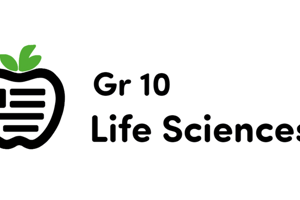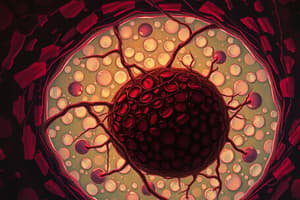Podcast
Questions and Answers
What cellular process characterizes cancer?
What cellular process characterizes cancer?
- Out-of-control cell growth (correct)
- Controlled cell division
- Normal cell apoptosis
- Regulated cell differentiation
How do cancer cells interact with normal cells?
How do cancer cells interact with normal cells?
- They support the growth of normal cells.
- They grow and replace normal cells. (correct)
- They divide in an orderly fashion like normal cells.
- They enhance the function of normal cells.
Why do different forms of cancer often require different treatment strategies?
Why do different forms of cancer often require different treatment strategies?
- Cancer treatments are universally effective regardless of cancer type.
- All cancers respond identically to the same treatments.
- Different cancers grow at different rates and respond to different treatments. (correct)
- Different cancers grow at the same rate and behave similarly.
What is the term for cancer that has reappeared after a period of remission?
What is the term for cancer that has reappeared after a period of remission?
If prostate cancer spreads to the bones, how is it classified?
If prostate cancer spreads to the bones, how is it classified?
How does the duration of interphase differ in cancer cells compared to normal cells?
How does the duration of interphase differ in cancer cells compared to normal cells?
Which of the following generally describes the appearance of cancerous cells compared to normal cells?
Which of the following generally describes the appearance of cancerous cells compared to normal cells?
What is a key difference between benign and malignant tumors?
What is a key difference between benign and malignant tumors?
Which of the following is a characteristic of benign tumors?
Which of the following is a characteristic of benign tumors?
What is a defining feature of malignant tumors regarding their interaction with surrounding tissues?
What is a defining feature of malignant tumors regarding their interaction with surrounding tissues?
Which of these factors is considered a root cause or co-factor of cancer development?
Which of these factors is considered a root cause or co-factor of cancer development?
Which substance is known to cause cancer in various parts of the body?
Which substance is known to cause cancer in various parts of the body?
Targeted therapy is a procedure for cancer treatment, what are the other options?
Targeted therapy is a procedure for cancer treatment, what are the other options?
What is the term for the failure of homologous chromosomes or sister chromatids to separate during cell division?
What is the term for the failure of homologous chromosomes or sister chromatids to separate during cell division?
What condition results from having only one copy of a chromosome instead of the usual two?
What condition results from having only one copy of a chromosome instead of the usual two?
Which condition is characterized by the presence of an additional chromosome within a set?
Which condition is characterized by the presence of an additional chromosome within a set?
How is Turner syndrome related to the concepts of monosomy and trisomy?
How is Turner syndrome related to the concepts of monosomy and trisomy?
Which genetic abnormality is associated with Down syndrome?
Which genetic abnormality is associated with Down syndrome?
What is the process of karyotyping primarily used for?
What is the process of karyotyping primarily used for?
Which of the following is a key feature of karyotypes that aids in identifying chromosomal abnormalities?
Which of the following is a key feature of karyotypes that aids in identifying chromosomal abnormalities?
What chromosomal abnormality characterizes Patau Syndrome (Trisomy 13)?
What chromosomal abnormality characterizes Patau Syndrome (Trisomy 13)?
Which of the following would be a symptom associated with Patau Syndrome (Trisomy 13)?
Which of the following would be a symptom associated with Patau Syndrome (Trisomy 13)?
What is the prognosis for infants born with Patau Syndrome (Trisomy 13)?
What is the prognosis for infants born with Patau Syndrome (Trisomy 13)?
Which chromosomal abnormality is associated with Edward's syndrome?
Which chromosomal abnormality is associated with Edward's syndrome?
What are some of the symptoms of Edward's Syndrome?
What are some of the symptoms of Edward's Syndrome?
What genetic condition results from a male being born with an extra X chromosome?
What genetic condition results from a male being born with an extra X chromosome?
Which physical characteristic is commonly associated with Klinefelter’s Syndrome?
Which physical characteristic is commonly associated with Klinefelter’s Syndrome?
Which of the following genotypes is characteristic of a male with XYY syndrome?
Which of the following genotypes is characteristic of a male with XYY syndrome?
Which characteristics are frequently observed in individuals with XYY syndrome?
Which characteristics are frequently observed in individuals with XYY syndrome?
What chromosomal anomaly is associated with Triple X Syndrome?
What chromosomal anomaly is associated with Triple X Syndrome?
Which of the following traits is not typically associated with individuals diagnosed with Triple X Syndrome?
Which of the following traits is not typically associated with individuals diagnosed with Triple X Syndrome?
What is the genetic basis of Turner syndrome?
What is the genetic basis of Turner syndrome?
What genetic condition is defined by a person having 3 chromosome 21 instead of 2?
What genetic condition is defined by a person having 3 chromosome 21 instead of 2?
Which of the following physical features is associated with Down Syndrome?
Which of the following physical features is associated with Down Syndrome?
Which of the following best describes how Turner syndrome is typically inherited?
Which of the following best describes how Turner syndrome is typically inherited?
Why does Nondisjunction matter in development of Genetic Disorders?
Why does Nondisjunction matter in development of Genetic Disorders?
In most cases of Turner Syndrome, which parent does the single X chromosome most commonly come from?
In most cases of Turner Syndrome, which parent does the single X chromosome most commonly come from?
Which of the following is a common characteristic of Turner Syndrome?
Which of the following is a common characteristic of Turner Syndrome?
Flashcards
Cancer
Cancer
A condition where cells divide uncontrollably, ignoring normal cell growth regulation.
Cancer Metastasis
Cancer Metastasis
The process where cancer spreads from its origin to other body parts, named after the original site.
Cancer Recurrence
Cancer Recurrence
The return of cancer after a period of remission.
Interphase in Cancer Cells
Interphase in Cancer Cells
Signup and view all the flashcards
Tumor
Tumor
Signup and view all the flashcards
Benign Tumors
Benign Tumors
Signup and view all the flashcards
Malignant Tumors
Malignant Tumors
Signup and view all the flashcards
Nondisjunction
Nondisjunction
Signup and view all the flashcards
Chromosome Monosomy
Chromosome Monosomy
Signup and view all the flashcards
Chromosome Trisomy
Chromosome Trisomy
Signup and view all the flashcards
Karyotyping
Karyotyping
Signup and view all the flashcards
Down Syndrome
Down Syndrome
Signup and view all the flashcards
Patau Syndrome (Trisomy 13)
Patau Syndrome (Trisomy 13)
Signup and view all the flashcards
Edward's Syndrome (Trisomy 18)
Edward's Syndrome (Trisomy 18)
Signup and view all the flashcards
Klinefelter's Syndrome
Klinefelter's Syndrome
Signup and view all the flashcards
XYY Syndrome
XYY Syndrome
Signup and view all the flashcards
Triple X Syndrome
Triple X Syndrome
Signup and view all the flashcards
Turner Syndrome
Turner Syndrome
Signup and view all the flashcards
Study Notes
- Cancer is defined as a condition of uncontrolled cell division.
- While normal cells follow an orderly division and growth process, cancer cells do not.
- Cancer cells grow and impede normal cells.
- Numerous forms of cancer exist and are characterized by their uncontrolled cellular growth.
- Different cancer types exhibit varied behaviors.
- Lung and breast cancer grow at different rates and respond differently to treatments.
- Cancer cells can create tumors that deplete bodily resources, leading to harm.
- These tumors are classified as benign or malignant.
- Cancer retains its original name even if it spreads to a new location in the body.
- Cancer recurrence refers to the return of cancer after a period of remission following treatment.
Cancer and Cell Cycle
- Interphase is the cell cycle's longest phase.
- Reduced interphase, especially G1/G2 in cancer cells.
- Cancer cells are often smaller but more abnormal than healthy cells.
Cancerous vs. Normal Cells
- Cancer cells differ visibly from normal cells in size and shape.
Tumors
- Benign tumors grow locally and do not spread, while malignant tumors invade neighboring tissues and may metastasize.
- Benign tumors are small, slow-growing, non-invasive, well-differentiated, remain localized and cannot invade other parts of the body.
- Malignant tumors are large, fast-growing, invasive, poorly differentiated, metastasize, destroy surrounding tissues, and spread to other body parts.
Causes of Cancer
- Factors contributing to cancer include smoking, obesity, viruses, chemicals, radiation, hormones, immune conditions, and inherited genetic mutations.
- Specific percentages of cancer causes are: diet (35%), smoking (30%), viruses/infections (10%), reproductive behavior (7%), family history (5%), occupation (4%), alcohol (3%), sunlight/radiation (3%), pollution (2%), and medical procedures (1%).
Cancer Treatment Options
- Cancer treatment includes hormone therapy, surgery, bone marrow transplantation, chemotherapy, immunotherapy, radiation therapy, and targeted therapy.
- Root causes of cancer include chronic inflammation, oxidative stress, and toxicity/acidity. Contributing factors include Type 2 diabetes, obesity, sedentary lifestyle, weakened immunity, poor diet, genetics, environmental toxins, smoking/alcohol, stress/insomnia, nutrient deficiencies, and enzyme/probiotic deficiencies.
- Tobacco use causes cancer throughout the body.
- Types include mouth, throat, esophagus, larynx, lung, bronchus, trachea, acute myeloid leukemia, liver, stomach, pancreas, kidney, renal pelvis, urinary bladder, uterine cervix, colon and rectum
Nondisjunction
- This is a condition where homologous chromosomes or sister chromatids fail to separate properly during cell meiosis I or meiosis II.
- In Meiosis 1 a pair of homologous chromosome does not separate causing both chromosomes to go to one daughter cells and neither to the other
- In Meiosis 2 a sister chromatid does not separate causing both chromatids to go to one daughter cell and non to the other
- Nondisjunction leads to monosomy, where there's one copy of a chromosome, or trisomy, where there are three copies.
- Monosomy is a condition of having a diploid chromosome complement with one chromosome lacking its homologous partner.
- Monosomy features a single chromosome in the homologous pair.
- This can be represented as 2n-1.
- Turner syndrome serves as an example.
- Trisomy describes the condition of having an extra chromosome in the genome.
- Presence of an additional chromosome.
- Represented as 2n+1.
- Down syndrome serves as an example.
- A number of disorders are caused by non-disjunctions, these include; Down's Syndrome, Edward's Syndrome, Patau's Syndrome, Turner's Syndrome, Kleinfelter's Syndrome and other severe abnormalities
Genetic Diseases
- Non-disjunction and polyploidy can cause Down Syndrome: trisomy of chromosome 21
- Non-disjunction and polyploidy can cause Patau Syndrome: trisomy of chromosome 13
- Non-disjunction and polyploidy can cause Edward Syndrome: trisomy of chromosome 18
- Non-disjunction and polyploidy can cause Klinefelter Syndrome: an extra X chromosome in males
- Non-disjunction and polyploidy can cause Turner Syndrome: only one X chromosome present in females
- Non-disjunction and polyploidy can cause XYY Syndrome: an extra Y chromosome in males
- Non-disjunction and polyploidy can cause Triple X Syndrome: an extra X chromosome in females
Karyotype
- Karyotyping is the process of pairing and ordering an organism's chromosomes.
- Its a genome-wide snapshot of an individual's chromosomes made in preparation with standardized staining procedures, revealing the charateristic structural features for each chromosome.
- Used in Down’s Syndrome karyotype
Patau Syndrome
- Patau syndrome (trisomy 13) is a chromosomal condition with associations to severe intellectual disability, physical abnormalities in many parts of the body and heart defects
- Other signs shown include brain or spinal cord abnormalities and very small or poorly developed eyes (microphthalmia).
- Extra fingers or toes can also be shown from this Trisomy.
- Openings in the lip (cleft lip) are possible with or without an opening in the roof of the mouth (a cleft palate),
- One more sign is weak muscle tone (hypotonia)
- Infants with trisomy 13 die within their first days or weeks of life.
- Only five percent to 10 percent of children live past their first year.
Edward’s Syndrome
- Edward's syndrome (trisomy 18) is known as the most severe form of trisomy 18.
- Affected babies likely die shortly after birth
- Unusual signs shown are a small head, prominent back of the head, and malformed, low-set ears
- Mouth and jaw are small with a cleft lip or cleft palate.
- Additional signs include hands clenched into fists, and the index finger overlapping the other fingers; clubfeet (or rocker bottom feet); and webbing or fusion of toes
Klinefelter’s Syndrome
- Klinefelter's Syndrome is a genetic condition stemming from males being born with an extra copy of the X chromosome.
- The syndrome goes undiagnosed till adulthood
- Testicular growth can be adversely affected, resulting in smaller than normal testicles and reducing production of testosterone.
- This syndrome may be accompanied by signs such as reduced muscle mass, reduced body and facial hair, and enlarged breast tissue.
- Affected men most like have little or now sperm, assisted reproductive procedures are available to support those who want to father children
XYY Syndrome
- XYY syndrome is a rare chromosomal disorder affecting males. -This disorder results from an extra Y chromosome.
- Those affected generally have one X and two Y chromosomes.
- Affected individuals are very tall and possess a less muscular body, broader hips and larger breast.
- Further signs include weaker bones, a lower energy level, and smaller penis and testicles.
- Potential for delayed puberty and less facial and body hair
Triple-x Syndrome
- Triple-X Syndrome only affects females and includes a Trisomy X; extra X chromosome at pair 23.
- Commonly the affected female will be taller than average and have no unusual features.
- Individuals have an increased risk of learning disabilities and delayed development of speech and language skills along with weak muscle tone, behavioral, and emotional difficulties.
Down’s Syndrome
- Down syndrome is an example of Trisomy 21 where Person has 3 chromosome 21 instead of 2,
- Down syndrome includes Hearing loss, heart and vision disorders, physical deformity (range), and mental/growth retardation
Turner Syndrome
- Turner's Syndrome is genetic in nature, mainly affecting females.
- Girls are missing one of their X chromosomes,intellectually normal, and physical/sexual maturity problems
- Turner's Syndrome affects 60,000 females in the United States.
- This disorder is seen in 1 of every 2000 to 2500 baby girls, with about 800 new cases diagnosed each year.
- Turner syndrome is caused by what is called non-disjunction when a pair of sex chromosomes.
- The sex chromosomes then fail to separate during the formation of a sperm or egg when normally, a girl inherits one X chromosome from her mother and one X chromosome from her father.
- Females tend to be shorter than average, and they have web-like necks, poorly developed breast, and immature internal sexual organs.
- Further conditions of sufferers include a reduced ability to interpret spatial relationships. Infertility is very common among many male related characteristics such as heavy neck muscles and narrow hips Older females have absent or incomplete development at puberty
- Females are absent or incomplete development at puberty alongside their broad chest and widely spaced nipples
Studying That Suits You
Use AI to generate personalized quizzes and flashcards to suit your learning preferences.




